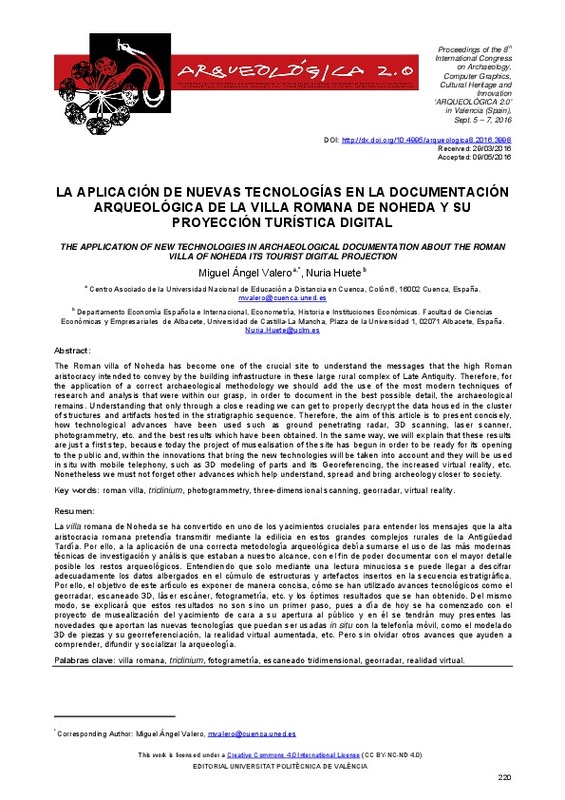JavaScript is disabled for your browser. Some features of this site may not work without it.
Buscar en RiuNet
Listar
Mi cuenta
Estadísticas
Ayuda RiuNet
Admin. UPV
LA APLICACIÓN DE NUEVAS TECNOLOGÍAS EN LA DOCUMENTACIÓN ARQUEOLÓGICA DE LA VILLA ROMANA DE NOHEDA Y SU PROYECCIÓN TURÍSTICA DIGITAL
Mostrar el registro sencillo del ítem
Ficheros en el ítem
| dc.contributor.author | Valero Tévar, Miguel Ángel
|
es_ES |
| dc.contributor.author | Huete Alcocer, Nuria
|
es_ES |
| dc.coverage.spatial | east=-2.259287699999959; north=40.1836034; name=Villar de Domingo García, Cuenca, Espanya | |
| dc.date.accessioned | 2017-07-31T10:40:02Z | |
| dc.date.available | 2017-07-31T10:40:02Z | |
| dc.date.issued | 2016-10-27 | |
| dc.identifier.isbn | 9788490484555 | |
| dc.identifier.uri | http://hdl.handle.net/10251/85994 | |
| dc.description.abstract | [EN] The Roman villa of Noheda has become one of the crucial site to understand the messages that the high Roman aristocracy intended to convey by the building infrastructure in these large rural complex of Late Antiquity. Therefore, for the application of a correct archaeological methodology we should add the use of the most modern techniques of research and analysis that were within our grasp, in order to document in the best possible detail, the archaeological remains. Understanding that only through a close reading we can get to properly decrypt the data housed in the cluster of structures and artifacts hosted in the stratigraphic sequence. Therefore, the aim of this article is to present concisely, how technological advances have been used such as ground penetrating radar, 3D scanning, laser scanner, photogrammetry, etc. and the best results which have been obtained. In the same way, we will explain that these results are just a first step, because today the project of musealisation of the site has begun in order to be ready for its opening to the public and, within the innovations that bring the new technologies will be taken into account and they will be used in situ with mobile telephony, such as 3D modeling of parts and its Georeferencing, the increased virtual reality, etc. Nonetheless we must not forget other advances which help understand, spread and bring archeology closer to society | es_ES |
| dc.description.abstract | [ES] La villa romana de Noheda se ha convertido en uno de los yacimientos cruciales para entender los mensajes que la alta aristocracia romana pretendía transmitir mediante la edilicia en estos grandes complejos rurales de la Antigüedad Tardía. Por ello, a la aplicación de una correcta metodología arqueológica debía sumarse el uso de las más modernas técnicas de investigación y análisis que estaban a nuestro alcance, con el fin de poder documentar con el mayor detalle posible los restos arqueológicos. Entendiendo que solo mediante una lectura minuciosa se puede llegar a descifrar adecuadamente los datos albergados en el cúmulo de estructuras y artefactos insertos en la secuencia estratigráfica. Por ello, el objetivo de este artículo es exponer de manera concisa, cómo se han utilizado avances tecnológicos como el georradar, escaneado 3D, láser escáner, fotogrametría, etc. y los óptimos resultados que se han obtenido. Del mismo modo, se explicará que estos resultados no son sino un primer paso, pues a día de hoy se ha comenzado con el proyecto de musealización del yacimiento de cara a su apertura al público y en él se tendrán muy presentes las novedades que aportan las nuevas tecnologías que puedan ser usadas in situ con la telefonía móvil, como el modelado 3D de piezas y su georreferenciación, la realidad virtual aumentada, etc. Pero sin olvidar otros avances que ayuden a comprender, difundir y socializar la arqueología. | es_ES |
| dc.format.extent | 11 | es_ES |
| dc.language | Español | es_ES |
| dc.publisher | Editorial Universitat Politècnica de València | es_ES |
| dc.relation.ispartof | 8th International congress on archaeology, computer graphics, cultural heritage and innovation | es_ES |
| dc.rights | Reconocimiento - No comercial - Sin obra derivada (by-nc-nd) | es_ES |
| dc.subject | Data acquisition | es_ES |
| dc.subject | Photogrammetry | es_ES |
| dc.subject | Remote sensing | es_ES |
| dc.subject | Documentation | es_ES |
| dc.subject | Cultural heritage | es_ES |
| dc.subject | Digitisation | es_ES |
| dc.subject | 3D modelling | es_ES |
| dc.subject | Virtual archaeology | es_ES |
| dc.subject | Virtual museums | es_ES |
| dc.subject | Virtual exhibitions | es_ES |
| dc.subject | Gaming | es_ES |
| dc.subject | Collaborative environments | es_ES |
| dc.subject | Internet technology | es_ES |
| dc.subject | Social media | es_ES |
| dc.subject | Architecture | es_ES |
| dc.title | LA APLICACIÓN DE NUEVAS TECNOLOGÍAS EN LA DOCUMENTACIÓN ARQUEOLÓGICA DE LA VILLA ROMANA DE NOHEDA Y SU PROYECCIÓN TURÍSTICA DIGITAL | es_ES |
| dc.title.alternative | THE APPLICATION OF NEW TECHNOLOGIES IN ARCHAEOLOGICAL DOCUMENTATION ABOUT THE ROMAN VILLA OF NOHEDA ITS TOURIST DIGITAL PROJECTION | es_ES |
| dc.type | Capítulo de libro | es_ES |
| dc.type | Comunicación en congreso | es_ES |
| dc.identifier.doi | 10.4995/arqueologica8.2015.3998 | |
| dc.rights.accessRights | Abierto | es_ES |
| dc.description.bibliographicCitation | Valero Tévar, MÁ.; Huete Alcocer, N. (2016). LA APLICACIÓN DE NUEVAS TECNOLOGÍAS EN LA DOCUMENTACIÓN ARQUEOLÓGICA DE LA VILLA ROMANA DE NOHEDA Y SU PROYECCIÓN TURÍSTICA DIGITAL. En 8th International congress on archaeology, computer graphics, cultural heritage and innovation. Editorial Universitat Politècnica de València. 220-230. https://doi.org/10.4995/arqueologica8.2015.3998 | es_ES |
| dc.description.accrualMethod | OCS | es_ES |
| dc.relation.conferencename | ARQUEOLÓGICA 2.0 - 8th International Congress on Archaeology, Computer Graphics, Cultural Heritage and Innovation | es_ES |
| dc.relation.conferencedate | September 05-07,2016 | es_ES |
| dc.relation.conferenceplace | Valencia, Spain | es_ES |
| dc.relation.publisherversion | http://ocs.editorial.upv.es/index.php/arqueologica20/arqueologica8/paper/view/3998 | es_ES |
| dc.description.upvformatpinicio | 220 | es_ES |
| dc.description.upvformatpfin | 230 | es_ES |
| dc.type.version | info:eu-repo/semantics/publishedVersion | es_ES |
| dc.relation.pasarela | OCS\3998 | es_ES |








